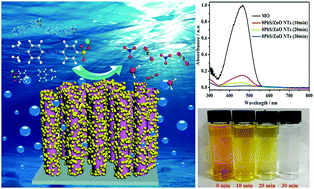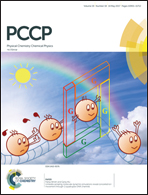Selectivity of quantum dot sensitized ZnO nanotube arrays for improved photocatalytic activity†
Abstract
In this work, PbS/ZnO, CdS/ZnO and CdSe/ZnO hierarchical heterostructures have been successfully synthesized by combining water bath and chemical bath deposition (CBD) methods on indium-doped tin oxide (ITO). Scanning electron microscopy (SEM) results show that quantum dots (QDs) certainly form on the pre-grown ZnO nanorod (NR) and nanotube (NT) arrays. The amount of QDs capped on ZnO could be regulated by varying the cycle times. The photocatalytic activity of the QD-sensitized ZnO is investigated by decomposition of methyl orange (MO) under irradiation, which show remarkable enhancement compared to bare ZnO. The ZnO NTs sensitized by PbS QDs have the highest catalytic activity among the three QDs (PbS, CdS and CdSe QDs). The UV-vis absorption diagrams and the Ct/C0 curves reveal that 8PbS/ZnO NTs have the highest catalytic activity, which can degrade MO (20 mg L−1) into a colorless solution within 30 min. Meanwhile, the synthetic methodology described herein provides an effective approach for fabricating a variety of photocatalysts. The heterostructured nanomaterials have significant potential to solve environmental and energy issues.



 Please wait while we load your content...
Please wait while we load your content...